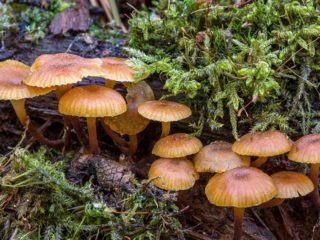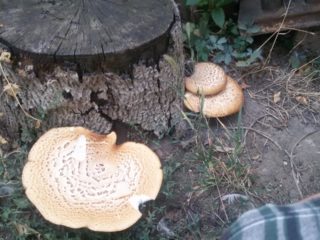Content
Leocarpus fragilis is an unusual fruiting body belonging to the myxomycetes. Belongs to the family Physarales and genus Physaraceae. At a young age, it resembles lower animals, and in adulthood it becomes similar to familiar mushrooms. Its other names:
- Lycoperdon fragile;
- Leocarpus vernicosus;
- Leangium or Physarum vernicosum;
- Diderma vernicosum.

The colony of this fungus looks like strange small berries or insect eggs
Where does Leocarpus brittle grow?
Leocarpus fragile is a cosmopolitan plant, distributed throughout the globe in temperate, subarctic and subtropical climate zones, in areas with a boreal climate. It has never been found in deserts, steppes or humid tropics. In Russia it is found everywhere, especially abundantly in taiga zones. Loves small-leaved and mixed forests, pine forests and spruce forests, often settles in blueberry forests.
Leocarpus brittle is not picky about the composition of the substrate and the nutritional value of the soil.Grows on dead parts of trees and shrubs: branches, bark, dead wood, in rotting stumps and fallen trunks, on leaf litter. It can also develop on living plants: trunks, branches and leaves of trees, grass, stems and shrubs. Sometimes you can see the droppings of ruminants and birds.
In the plasmodium state, these organisms are quite active in order to migrate long distances and climb to their favorite places on the treetops. Attaching itself to the nutrient substrate with a thin stalked flagellum, Leocarpus fragile turns into sporangia, arranged in close dense groups. It is very rarely seen alone.

Leocarpus brittle grows in close-knit groups, forming bright shiny garlands
What does Leocarpus brittle look like?
In their motile plasmodium form, these organisms are amber-yellow or reddish in color. Sporangia are round, drop-shaped or spherical in shape. Very rarely they are elongated-cylindrical. They press tightly against the host plant. The leg is short, thread-like, white or light sand color.
The diameter varies from 0.3 to 1.7 mm, the height is 0.5-5 mm during spore maturation. The shell is three-layered: a fragile outer layer, a thick defoliated middle layer and a filmy thin inner layer.
The fruiting bodies that have just appeared have a sunny yellow color, which, as they develop, darkens first to red-honey, and then to brick-brown and violet-black. The surface is smooth, varnish-shiny, dry, very brittle. Ripe spores break through the skin, which has thinned to a parchment state, and fly away. Spore powder is black.

Leocarpus brittle is very similar to other types of yellow-colored slime molds
Is it possible to eat Leocarpus fragile?
There is no exact information about the edibility of this organism. The issue has been little studied, so Leocarpus brittle is considered an inedible species.

Leocarpus brittle of coral color on a fallen tree trunk
Conclusion
Leocarpus brittle belongs to the unique creatures of nature, the animal fungi. At a young age, they demonstrate the behavior of simple organisms and are able to move; adult specimens have all the signs of ordinary mushrooms. Classified as inedible species. Distributed widely throughout the globe, with the exception of the hot tropics and eternal ice. They are similar to other types of myxomycetes in red and yellow shades.








